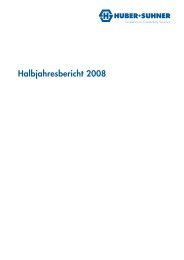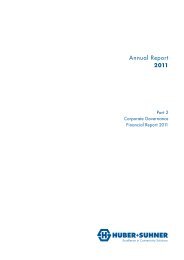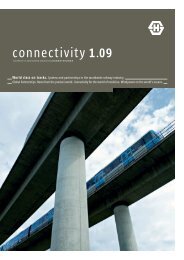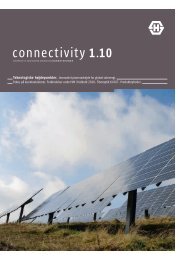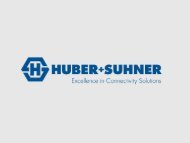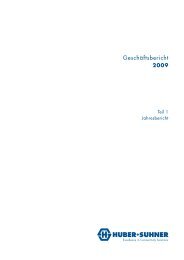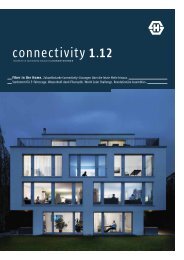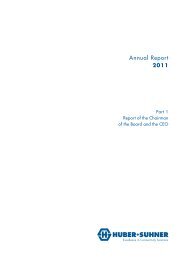Annual Report
Annual Report
Annual Report
You also want an ePaper? Increase the reach of your titles
YUMPU automatically turns print PDFs into web optimized ePapers that Google loves.
They are recognised in the balance sheet at their net realisable<br />
value. A provision for impairment is recognised if<br />
there are objective indications that the receivable amounts<br />
due cannot be recovered completely. Reductions in value<br />
are recognised in the income statement. These amounts<br />
correspond approximately to the fair value.<br />
Cash and cash equivalents include cash on hand, postal<br />
and bank accounts, cheques and fixed-term deposits with<br />
an original maturity of less than 3 months.<br />
Borrowings include credit, lease and loan liabilities and are<br />
recognised initially at fair value before transaction costs<br />
incurred. Borrowings are subsequently stated at amortised<br />
costs; any difference between the proceeds and the<br />
redemption value is recognised in the income statement<br />
over the period of the borrowing using the effective interest<br />
method.<br />
All borrowing costs (interest, etc.) are recognised as an<br />
expense in the period in which they are incurred.<br />
Loans or other long-term financial assets are non-derivative<br />
financial assets with fixed or determinable payments<br />
that are not quoted in an active market. They arise when<br />
the Group provides money, goods or services directly to a<br />
debtor with no intention of trading the receivables. Loans<br />
are recognised at amortised cost which corresponds in<br />
general to the nominal value. They are reviewed regularly<br />
for impairment. Loans are included in current assets, except<br />
for those with maturities greater than 12 months after<br />
the balance sheet date. These are classified as non-current<br />
assets.<br />
2.7 Cash and cash equivalents<br />
Cash and cash equivalents are stated at nominal value.<br />
They include cash on hand, postal and bank accounts,<br />
cheques and fixed-term deposits with an original maturity<br />
of less than 3 months.<br />
2.8 Trade receivables<br />
Trade receivables are measured at amortised cost less<br />
allowances. Indications for impairment are: substantial<br />
financial problems of the customer, a declaration of bankruptcy,<br />
or a material delay in payment.<br />
2.9 Inventories<br />
Inventories are stated at the lower of cost and net realisable<br />
value. The cost of goods comprises direct material<br />
and production costs and related production overheads. It<br />
excludes borrowing costs. The valuation of the inventory is<br />
based on standard costs that are verified annually. Slowmoving<br />
and obsolete stock that have insufficient inventory<br />
turn are systematically partially or fully revaluated.<br />
Trade discounts from suppliers are deducted from purchasing<br />
costs.<br />
Notes to Group Financial Statements<br />
HUBER+SUHNER <strong>Annual</strong> <strong>Report</strong> 2010 · Part 2<br />
2.10 Property, plant and equipment<br />
Property, plant and equipment are stated on the balance<br />
sheet at the purchased or manufactured cost less accumulated<br />
depreciation. Depreciation is charged using the<br />
straight-line method over the estimated useful lives of the<br />
related assets. Land is not depreciated.<br />
Land Indefinite useful life<br />
Buildings 20–50 years<br />
Technical equipment and machinery 3–15 years<br />
Plant, office furniture and fixtures 3–10 years<br />
Gains and losses on disposals of property, plant and equipment<br />
are included in other operating revenue and expenses<br />
in the income statement. Purchases of minor value are immediately<br />
expensed in the income statement.<br />
2.11 Leasing<br />
Assets that are purchased under finance leasing are recognised<br />
at net present value of the future minimum leasing<br />
rates. These correspond to the fair value at the beginning<br />
of the lease. The present value of the future minimum<br />
leasing rates is recognised as finance lease liability and<br />
the leased assets are depreciated over their useful lives.<br />
Payments made under operating lease are charged to the<br />
income statement on a straight-line basis over the period<br />
of the lease.<br />
2.12 Investment property<br />
Investment properties are held to earn rental income and<br />
capital gains. They are valued at purchase cost less accumulated<br />
depreciation and impairments. Investment properties<br />
are depreciated using the straight-line method over<br />
their estimated useful life (20 to 50 years).<br />
In accordance with IAS 40, the fair value is shown in the<br />
notes for comparison. It is calculated based on internal net<br />
present value or DCF method.<br />
2.13 Intangible assets<br />
Goodwill<br />
Goodwill represents the excess of the cost of an acquisition<br />
over the Groups’ share at fair value of the assets, the<br />
amount of non-controlled shares at the acquired company<br />
as well as the fair value of all prior hold shares at the date<br />
of acquisition over the share of the Group at the net assets<br />
valued at fair value. If the costs of an acquisition are lower<br />
than the net assets valued at fair value of the acquired<br />
company the difference is directly recognised in profit and<br />
loss. The HUBER+SUHNER Group have no capitalised<br />
goodwill.<br />
21




